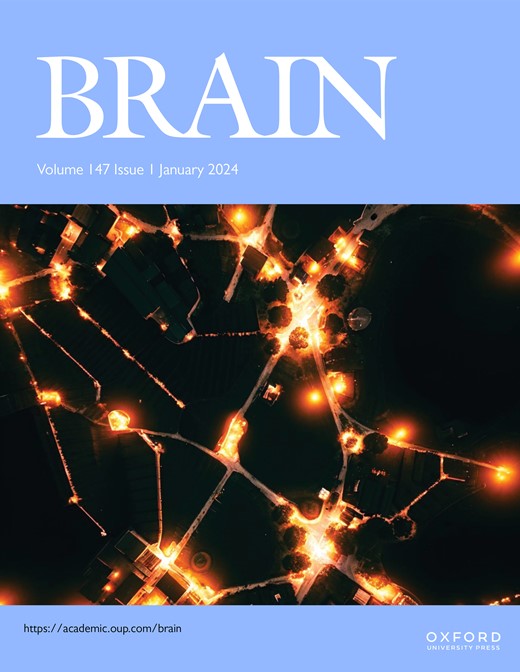帕金森病患者衍生的 GBA1 中脑器官组织中路易病变的形成
IF 10.6
1区 医学
Q1 CLINICAL NEUROLOGY
引用次数: 0
摘要
路易体包涵体中α-突触核蛋白的纤维状聚集和黑质纹状体多巴胺能神经元变性是帕金森病神经病理学的特征。编码葡萄糖脑苷脂酶的 GBA1 基因突变是帕金森病最常见的遗传风险因素。然而,由于缺乏能够再现关键神经病理学特征的可靠实验模型,阻碍了阐明突变葡萄糖脑苷脂酶与帕金森病病理之间的联系。在这里,我们描述了一种创新方案,该方案可生成人类诱导多能干细胞衍生的中脑器官组织,其中包含具有黑质特征的多巴胺能神经元,再现了高级成熟的特征。当应用于与GBA1相关的帕金森病患者时,这种方法使中脑器官组织的分化再现了多巴胺能神经元的缺失和在人脑中观察到的路易体病理学的基本特征,包括生成具有播种活性的α-突触核蛋白纤维聚集体,这种聚集体也会在健康对照器官组织中传播病理学。我们还观察到,突变体葡萄糖脑苷脂在内质网中的保留及其底物葡萄糖苷甘油酰胺水平的增加是α-突触核蛋白聚集成路易体样内含物的决定因素。同样,葡萄糖脑苷脂酶活性的降低促进了纤维状α-突触核蛋白的沉积,从而加速了α-突触核蛋白的病理变化。最后,我们证明了氨溴索和GZ667161--两种正在临床开发用于治疗GBA1相关帕金森病的葡萄糖脑苷脂通路调节剂--在该模型中减少α-突触核蛋白病理变化的功效,从而支持将中脑器官组织作为临床前研究药物筛选的相关平台。本文章由计算机程序翻译,如有差异,请以英文原文为准。
Lewy pathology formation in patient-derived GBA1 Parkinson’s disease midbrain organoids
Fibrillary aggregation of α-synuclein in Lewy body inclusions and nigrostriatal dopaminergic neuron degeneration define Parkinson’s disease neuropathology. Mutations in GBA1, encoding glucocerebrosidase, are the most frequent genetic risk factor for Parkinson’s disease. However, the lack of reliable experimental models able to reproduce key neuropathological signatures has hampered the clarification of the link between mutant glucocerebrosidase and Parkinson’s disease pathology. Here, we describe an innovative protocol for the generation of human induced pluripotent stem cell-derived midbrain organoids containing dopaminergic neurons with nigral identity that reproduce characteristics of advanced maturation. When applied to patients with GBA1-related Parkinson’s disease, this method enabled the differentiation of midbrain organoids recapitulating dopaminergic neuron loss and fundamental features of Lewy body pathology observed in human brains, including the generation of α-synuclein fibrillary aggregates with seeding activity that also propagate pathology in healthy control organoids. Still, we observed that the retention of mutant glucocerebrosidase in the endoplasmic reticulum and increased levels of its substrate glucosylceramide are determinants of α-synuclein aggregation into Lewy body-like inclusions. Consistently, the reduction of glucocerebrosidase activity accelerated α-synuclein pathology by promoting fibrillary α-synuclein deposition. Finally, we demonstrated the efficacy of ambroxol and GZ667161 – two modulators of the glucocerebrosidase pathway in clinical development for the treatment of GBA1-related Parkinson’s disease – in reducing α-synuclein pathology in this model, supporting the use of midbrain organoids as a relevant pre-clinical platform for investigational drug screening.
求助全文
通过发布文献求助,成功后即可免费获取论文全文。
去求助
来源期刊

Brain
医学-临床神经学
CiteScore
20.30
自引率
4.10%
发文量
458
审稿时长
3-6 weeks
期刊介绍:
Brain, a journal focused on clinical neurology and translational neuroscience, has been publishing landmark papers since 1878. The journal aims to expand its scope by including studies that shed light on disease mechanisms and conducting innovative clinical trials for brain disorders. With a wide range of topics covered, the Editorial Board represents the international readership and diverse coverage of the journal. Accepted articles are promptly posted online, typically within a few weeks of acceptance. As of 2022, Brain holds an impressive impact factor of 14.5, according to the Journal Citation Reports.
 求助内容:
求助内容: 应助结果提醒方式:
应助结果提醒方式:


